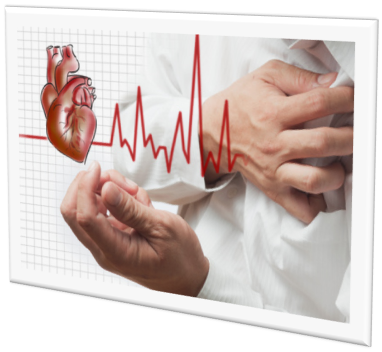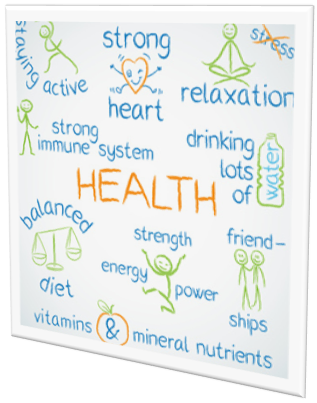Heart-healthy
diet: 8 steps to prevent heart disease
Although you might
know that eating certain foods can increase your heart disease risk, it's often
tough to change your eating habits. Whether you have years of unhealthy eating
under your belt or you simply want to fine-tune your diet, here are eight heart-healthy
diet tips. Once you know which foods to eat more of and which foods to limit,
you'll be on your way toward a heart-healthy diet.
1. Control your
portion size
How much you eat is
just as important as what you eat. Overloading your plate, taking seconds and
eating until you feel stuffed can lead to eating more calories, fat and
cholesterol than you should. Portions served in restaurants are often more than
anyone needs. Keep track of the number of servings you eat — and use proper
serving sizes — to help control your portions. Eating more of low-calorie,
nutrient-rich foods, such as fruits and vegetables, and less of high-calorie,
high-sodium foods, such as refined, processed or fast foods, can shape up your
diet as well as your heart and waistline.
A serving size is a
specific amount of food, defined by common measurements such as cups, ounces or
pieces. For example, one serving of pasta is 1/2 cup, or about the size of a
hockey puck. A serving of meat, fish or chicken is 2 to 3 ounces, or about the
size and thickness of a deck of cards. Judging serving size is a learned skill.
You may need to use measuring cups and spoons or a scale until you're
comfortable with your judgment.
2. Eat more vegetables
and fruits
Vegetables and fruits
are good sources of vitamins and minerals. Vegetables and fruits are also low
in calories and rich in dietary fiber. Vegetables and fruits contain substances
found in plants that may help prevent cardiovascular disease. Eating more
fruits and vegetables may help you eat less high-fat foods, such as meat,
cheese and snack foods. Featuring vegetables
and fruits in your diet can be easy. Keep vegetables washed and cut in your
refrigerator for quick snacks. Keep fruit in a bowl in your kitchen so that
you'll remember to eat it. Choose recipes that have vegetables or fruits as the
main ingredient, such as vegetable stir-fry or fresh fruit mixed into salads.
|
Fruits and
vegetables to choose
|
Fruits and
vegetables to avoid
|
|
·
Fresh or frozen
vegetables and fruits
·
Low-sodium canned
vegetables
·
Canned fruit packed
in juice or water
|
·
Coconut
·
Vegetables with
creamy sauces
·
Fried or breaded
vegetables
·
Canned fruit packed
in heavy syrup
·
Frozen fruit with
sugar added
|
3. Select whole grains
Whole grains are good
sources of fiber and other nutrients that play a role in regulating blood
pressure and heart health. You can increase the amount of whole grains in a
heart-healthy diet by making simple substitutions for refined grain products.
Or be adventuresome and try a new whole grain, such as whole-grain couscous,
quinoa or barley. Another easy way to
add whole grains to your diet is ground flaxseed. Flaxseeds are small brown
seeds that are high in fiber and omega-3 fatty acids, which can lower your
total blood cholesterol. You can grind the seeds in a coffee grinder or food
processor and stir a teaspoon of them into yogurt, applesauce or hot cereal.
|
Grain products to
choose
|
Grain products to
limit or avoid
|
|
·
Whole-wheat flour
·
Whole-grain bread,
preferably 100% whole-wheat bread or 100% whole-grain bread
·
High-fiber cereal
with 5 g or more of fiber in a serving
·
Whole grains such as
brown rice, barley and buckwheat (kasha)
·
Whole-grain pasta
·
Oatmeal (steel-cut
or regular)
·
Ground flaxseed
|
·
White, refined flour
·
White bread
·
Muffins
·
Frozen waffles
·
Corn bread
·
Doughnuts
·
Biscuits
·
Quick breads
·
Granola bars
·
Cakes
·
Pies
·
Egg noodles
·
Buttered popcorn
·
High-fat snack
crackers
|
4. Limit unhealthy
fats and cholesterol
Limiting how much
saturated and trans fats you eat is an important step to reduce your blood
cholesterol and lower your risk of coronary artery disease. A high blood
cholesterol level can lead to a buildup of plaques in your arteries, called
atherosclerosis, which can increase your risk of heart attack and stroke.
The American Heart
Association offers these guidelines for how much fat and cholesterol to include
in a heart-healthy diet:
|
Type of fat
|
Recommendation
|
|
Saturated fat
|
Less than 7% of your
total daily calories, or less than 14 g of saturated fat if you follow a
2,000-calorie-a-day diet
|
|
Trans fat
|
Less than 1% of your
total daily calories, or less than 2 g of trans fat if you follow a
2,000-calorie-a-day diet
|
|
Cholesterol
|
Less than 300 mg a
day for healthy adults; less than 200 mg a day for adults with high levels of
LDL ("bad") cholesterol or those who are taking
cholesterol-lowering medication
|
The best way to reduce
saturated and trans fats in your diet is to limit the amount of solid fats —
butter, margarine and shortening — you add to food when cooking and serving.
You can also reduce the amount of saturated fat in your diet by trimming fat
off your meat or choosing lean meats with less than 10 percent fat. You can also use
low-fat substitutions when possible for a heart-healthy diet. For example, top
your baked potato with salsa or low-fat yogurt rather than butter, or use
low-sugar fruit spread on your toast instead of margarine. You may also want to
check the food labels of some cookies, crackers and chips. Many of these snacks
— even those labeled "reduced fat" — may be made with oils containing
trans fats. One clue that a food has some trans fat in it is the phrase
"partially hydrogenated" in the ingredient list. When you do use fats,
choose monounsaturated fats, such as olive oil or canola oil. Polyunsaturated
fats, found in nuts and seeds, also are good choices for a heart-healthy diet.
When used in place of saturated fat, monounsaturated and polyunsaturated fats
may help lower your total blood cholesterol. But moderation is essential. All
types of fat are high in calories.
|
Fats to choose
|
Fats to limit
|
|
·
Olive oil
·
Canola oil
·
Margarine that's
free of trans fats
·
Cholesterol-lowering
margarine, such as Benecol, Promise Activ or Smart Balance
|
·
Butter
·
Lard
·
Bacon fat
·
Gravy
·
Cream sauce
·
Nondairy creamers
·
Hydrogenated
margarine and shortening
·
Cocoa butter, found
in chocolate
·
Coconut, palm,
cottonseed and palm-kernel oils
|
5. Choose low-fat
protein sources
Lean meat, poultry and
fish, low-fat dairy products, and egg whites or egg substitutes are some of
your best sources of protein. But be careful to choose lower fat options, such
as skim milk rather than whole milk and skinless chicken breasts rather than
fried chicken patties. Fish is another good
alternative to high-fat meats. And certain types of fish are rich in omega-3
fatty acids, which can lower blood fats called triglycerides. You'll find the
highest amounts of omega-3 fatty acids in cold-water fish, such as salmon,
mackerel and herring. Other sources are flaxseed, walnuts, soybeans and canola
oil. Legumes — beans, peas
and lentils — also are good sources of protein and contain less fat and no
cholesterol, making them good substitutes for meat. Substituting plant protein
for animal protein — for example, a soy or bean burger for a hamburger — will
reduce your fat and cholesterol intake.
|
Proteins to choose
|
Proteins to limit or
avoid
|
|
·
Low-fat dairy
products such as skim or low-fat (1%) milk, yogurt and cheese
·
Egg whites or egg
substitutes
·
Fish, especially
fatty, cold-water fish, such as salmon
·
Skinless poultry
·
Legumes
·
Soybeans and soy
products, for example, soy burgers and tofu
·
Lean ground meats
|
·
Full-fat milk and other
dairy products
·
Organ meats, such as
liver
·
Egg yolks
·
Fatty and marbled
meats
·
Spareribs
·
Cold cuts
·
Hot dogs and
sausages
·
Bacon
·
Fried or breaded
meats
|
6. Reduce the sodium
in your food
Eating a lot of sodium
can contribute to high blood pressure, a risk factor for cardiovascular
disease. Reducing sodium is an important part of a heart-healthy diet. The
Department of Agriculture recommends:
·
Healthy adults have no
more than 2,300 milligrams (mg) of sodium a day (about a teaspoon)
·
People age 51 or
older, African-Americans, and people who have been diagnosed with high blood
pressure, diabetes or chronic kidney disease have no more than 1,500 mg of
sodium a day. Although reducing the
amount of salt you add to food at the table or while cooking is a good first
step, much of the salt you eat comes from canned or processed foods, such as
soups and frozen dinners. Eating fresh foods and making your own soups and
stews can reduce the amount of salt you eat. If you like the convenience of
canned soups and prepared meals, look for ones with reduced sodium. Be wary of
foods that claim to be lower in sodium because they are seasoned with sea salt
instead of regular table salt — sea salt has the same nutritional value as
regular salt.
Another way to reduce
the amount of salt you eat is to choose your condiments carefully. Many
condiments are available in reduced-sodium versions, and salt substitutes can
add flavor to your food with less sodium.
|
Low-salt items to
choose
|
High-salt items to
avoid
|
|
·
Herbs and spices
·
Salt substitutes
·
Reduced-salt canned
soups or prepared meals
·
Reduced-salt
versions of condiments, such as reduced-salt soy sauce and reduced-salt
ketchup
|
·
Table salt
·
Canned soups and
prepared foods, such as frozen dinners
·
Tomato juice
·
Soy sauce
|
7. Plan ahead: Create
daily menus
You know what foods to
feature in your heart-healthy diet and which ones to limit. Now it's time to
put your plans into action. Create daily menus
using the six strategies listed above. When selecting foods for each meal and
snack, emphasize vegetables, fruits and whole grains. Choose lean protein
sources and limit high-fat and salty foods. Watch your portion sizes and add
variety to your menu choices. For example, if you have grilled salmon one
evening, try a black-bean burger the next night. This helps ensure that you'll
get all of the nutrients your body needs. Variety also makes your meals and
snacks more interesting.
8. Allow yourself an
occasional treat
Allow yourself an
indulgence every now and then. A candy bar or handful of potato chips won't
derail your heart-healthy diet. But don't let it turn into an excuse for giving
up on your healthy-eating plan. If overindulgence is the exception, rather than
the rule, you'll balance things out over the long term. What's important is
that you eat healthy foods most of the time.
Incorporate these
eight tips into your life, and you'll continue to find that heart-healthy
eating is both doable and enjoyable. With planning and a few simple
substitutions, you can eat with your heart in mind.



 February is American Heart Month. The impact of heart disease is significant, since it affects the quality of life. According to the Centers for Disease Control and Prevention (CDC), cardiovascular disease is the leading cause of death in the United States; one in every three deaths is from heart disease and stroke, equal to 2,200 deaths per day.
February is American Heart Month. The impact of heart disease is significant, since it affects the quality of life. According to the Centers for Disease Control and Prevention (CDC), cardiovascular disease is the leading cause of death in the United States; one in every three deaths is from heart disease and stroke, equal to 2,200 deaths per day. The average heart rate of an average adult is 72 beats per minute. If you live to be 80 years old, your heart could beat almost 3 billion times. The heart is an amazing organ that keeps beating involuntarily and powers blood circulation for the entire body. Here are some important considerations for heart health.
The average heart rate of an average adult is 72 beats per minute. If you live to be 80 years old, your heart could beat almost 3 billion times. The heart is an amazing organ that keeps beating involuntarily and powers blood circulation for the entire body. Here are some important considerations for heart health. Although exercise is an important part of heart disease prevention, it is important to remember the ABCS of a healthy heart. Consult your physician for more information on these four key factors:
Although exercise is an important part of heart disease prevention, it is important to remember the ABCS of a healthy heart. Consult your physician for more information on these four key factors: